Shikoku Region
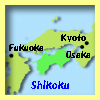 Shikoku ( right ) is the smallest of four main islands of Japan. Its population is less than 3.9 million ( less than 3.1 percent of the population of Japan ), though there are four prefectures in Shikoku. However there are castles and onsen hot springs while Awa Odori ( Awa Dance ) and Ningyo Joruri ( Bunraku or Japanese puppet show ) are popular among tourists. Also Sanuki Udon ( Sanuki wheat-flour noodles ) are so famous.
Shikoku ( right ) is the smallest of four main islands of Japan. Its population is less than 3.9 million ( less than 3.1 percent of the population of Japan ), though there are four prefectures in Shikoku. However there are castles and onsen hot springs while Awa Odori ( Awa Dance ) and Ningyo Joruri ( Bunraku or Japanese puppet show ) are popular among tourists. Also Sanuki Udon ( Sanuki wheat-flour noodles ) are so famous.
Sanuki Udon
 Kagawa Prefecture, located in the north-east of Shikoku Region, used to be called Sanuki Province, which is so famous for Sanuki Udon. There are many people who visit Kagawa Prefecture to eat Sanuki Udon, which is one of the best udon ( Japanese wheat-flour noodles ) in Japan.
Kagawa Prefecture, located in the north-east of Shikoku Region, used to be called Sanuki Province, which is so famous for Sanuki Udon. There are many people who visit Kagawa Prefecture to eat Sanuki Udon, which is one of the best udon ( Japanese wheat-flour noodles ) in Japan.
Tokushima City
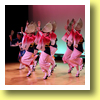 Tokushima City, the capital city of Tokushima Prefecture, used to be the capital city of Awa Feudal Domain during Tokugawa Period ( ==> A History of Japan vol.2 Samurai Age ). Tokushima is so famous for Awa Odori ( Awa Dance - right ) and there in the city is a theatre where tourists could enjoy watching Awa Odori dance almost everyday all year round.
Tokushima City, the capital city of Tokushima Prefecture, used to be the capital city of Awa Feudal Domain during Tokugawa Period ( ==> A History of Japan vol.2 Samurai Age ). Tokushima is so famous for Awa Odori ( Awa Dance - right ) and there in the city is a theatre where tourists could enjoy watching Awa Odori dance almost everyday all year round.
Also there in Tokushima City is a theatre where tourists could enjoy Awa Ningyo Joruri ( traditional Japanese puppet show ) almost everyday all year round. In addition, there are several dozens of restaurants in the city which offer Tokushima Ramen as well as some offer Awa Odori chicken dishes, which is one of local specialty dishes.
Iya Valley and Mt. Tsurugi
 Iya Valley is famous for vine bridges, suspension bridges made of mountain vines such as Kazura-bashi Bridge ( right ). There in the area remain three vine bridges, which are so popular among tourists. It is said that such vine bridges were constructed in the 12th-13th century by the Taira Clan, who found a hideout in the valley after their having lost the war.
Iya Valley is famous for vine bridges, suspension bridges made of mountain vines such as Kazura-bashi Bridge ( right ). There in the area remain three vine bridges, which are so popular among tourists. It is said that such vine bridges were constructed in the 12th-13th century by the Taira Clan, who found a hideout in the valley after their having lost the war.
Iya Valley, located in the west of Tokushima Prefecture, had been isolated by mountains and gorges. Such remoteness protected refugees as well as its unique landscapes, culture and local specialty foods, which attract lots of tourists now. However public transporation is not well developed in the area. So a rental car or so would be helpful.
Also many tourists visit Oboke Gorge, which is located in the west of Iya Valley and Mt. Tsurugi, which is located to the east of the valley.
Matsuyama City
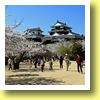 Matsuyama City, where more than half a million people live, is the capital city of Ehime Prefecture, located in the north-west of Shikoku Region. In the city, many tourists visit Matsuyama-jo Castle ( right ), one of original castles remaining in Japan. Also Dogo Onsen, one of the oldest and most famous onsen ( hot springs ) in Japan, is very popular among tourists.
Matsuyama City, where more than half a million people live, is the capital city of Ehime Prefecture, located in the north-west of Shikoku Region. In the city, many tourists visit Matsuyama-jo Castle ( right ), one of original castles remaining in Japan. Also Dogo Onsen, one of the oldest and most famous onsen ( hot springs ) in Japan, is very popular among tourists.
There are dozens of restaurants which serve Tai-Meshi ( rice boiled with sea bream ), one of the local specialties of Matsuyama and surrounding areas. Also people in the city love Nabeyaki-Udon ( Japanese wheat-flour noodles served in a pot with broth ).
Uwajima City
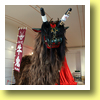 Through 22nd July to 24th July every year, Uwajima Ushi-oni Matsuri ( festival ) is held in Uwajima City, Ehime Prefecture. Among the attractions through the festival, Ushi-oni Parade is the most popular. So many paople look at dozens of Ushi-oni ( bull demons - right ) parading the city.
Through 22nd July to 24th July every year, Uwajima Ushi-oni Matsuri ( festival ) is held in Uwajima City, Ehime Prefecture. Among the attractions through the festival, Ushi-oni Parade is the most popular. So many paople look at dozens of Ushi-oni ( bull demons - right ) parading the city.
Also many people visit Uwajima City to enjoy Togyu ( bull sumo fighting ) tournaments which are held four times a year. Uwajima-jo Castle, one of twelve castles whose main keeps remain extant, is another one of popular tourist attractions. Two of the 88 temples consisting Shikoku Henro Pilgrimage are located in Uwajima City, where many pilgrims visit.
In addition, many restaurants and izakaya in Uwajima serve various kinds of local specialty dishes, such as Uwajima Tai-meshi. Also Jakoten is popular and famous and so nice with sake and beer.
Kochi City
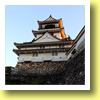 Kochi-jo Castle is one of the twelve castles whose main keeps remain extant. In addition, it is only one castle whose main palace remains adjacent to the main keep ( right ). 15 structures, including the main keep and the main palace, of the castle are designated National Important Cultural Properties of Japan. Kochi-jo Castle is one of the most popular tourist attractions in Kochi City.
Kochi-jo Castle is one of the twelve castles whose main keeps remain extant. In addition, it is only one castle whose main palace remains adjacent to the main keep ( right ). 15 structures, including the main keep and the main palace, of the castle are designated National Important Cultural Properties of Japan. Kochi-jo Castle is one of the most popular tourist attractions in Kochi City.
In addition, Hirome Ichiba Market, Chikurin-ji Temple, Makino Botanical Garden, Katsurahama Beach are popular among many rourists. Also tourists enjoy eating local specialty dishes such as Katsuo Tataki ( thich slices of slightly roasted bonito ) in Kochi City, which is the capital city of Kochi Prefecture.
Shikoku Henro Pilgrimage
 Shikoku Henro ( or O-Henro ) is a pilgrimage of 88 temples in Shikoku Region. So many pilgrims have walked through 1,200 - 1,400 km to visit the temples for several hundreds years. Even now many walk around Shikoku island for Henro Pilgrimage while much more use bicycles, cars, buses and/or public transportation.
Shikoku Henro ( or O-Henro ) is a pilgrimage of 88 temples in Shikoku Region. So many pilgrims have walked through 1,200 - 1,400 km to visit the temples for several hundreds years. Even now many walk around Shikoku island for Henro Pilgrimage while much more use bicycles, cars, buses and/or public transportation.
Pilgrims would see designated National Treasures and National Important Cultural Properties of Japan in the sites of the temples. Also they could enjoy viewing landscapes, visit castles and shrines and eat locat dishes achi-kochi ( here and there ) in Shikoku Region.
|